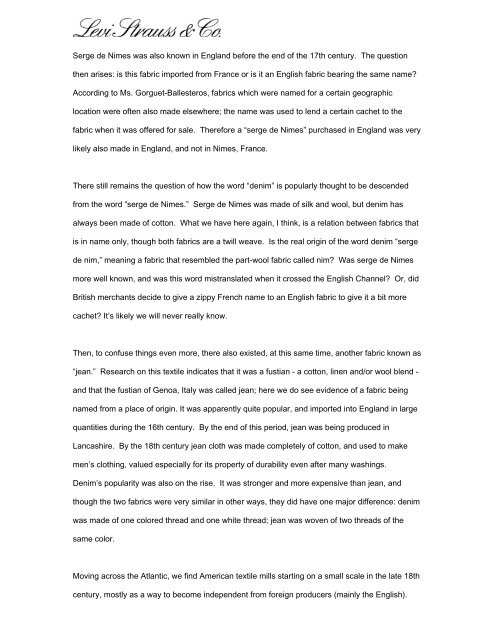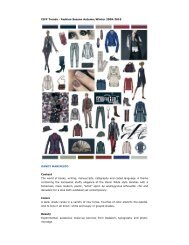You also want an ePaper? Increase the reach of your titles
YUMPU automatically turns print PDFs into web optimized ePapers that Google loves.
Serge de Nimes was also known in England before the end of the 17th century. The questionthen arises: is this fabric imported from France or is it an English fabric bearing the same name?According to Ms. Gorguet-Ballesteros, fabrics which were named for a certain geographiclocation were often also made elsewhere; the name was used to lend a certain cachet to thefabric when it was offered for sale. Therefore a “serge de Nimes” purchased in England was verylikely also made in England, and not in Nimes, France.There still remains the question of how the word “denim” is popularly thought to be descendedfrom the word “serge de Nimes.” Serge de Nimes was made of silk and wool, but denim hasalways been made of cotton. What we have here again, I think, is a relation between fabrics thatis in name only, though both fabrics are a twill weave. Is the real origin of the word denim “sergede nim,” meaning a fabric that resembled the part-wool fabric called nim? Was serge de Nimesmore well known, and was this word mistranslated when it crossed the English Channel? Or, didBritish merchants decide to give a zippy French name to an English fabric to give it a bit morecachet? It’s likely we will never really know.Then, to confuse things even more, there also existed, at this same time, another fabric known as“jean.” Research on this textile indicates that it was a fustian - a cotton, linen and/or wool blend -and that the fustian of Genoa, Italy was called jean; here we do see evidence of a fabric beingnamed from a place of origin. It was apparently quite popular, and imported into England in largequantities during the 16th century. By the end of this period, jean was being produced inLancashire. By the 18th century jean cloth was made completely of cotton, and used to makemen’s clothing, valued especially for its property of durability even after many washings.Denim’s popularity was also on the rise. It was stronger and more expensive than jean, andthough the two fabrics were very similar in other ways, they did have one major difference: denimwas made of one colored thread and one white thread; jean was woven of two threads of thesame color.Moving across the Atlantic, we find American textile mills starting on a small scale in the late 18thcentury, mostly as a way to become independent from foreign producers (mainly the English).



